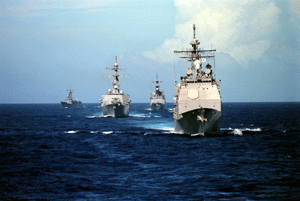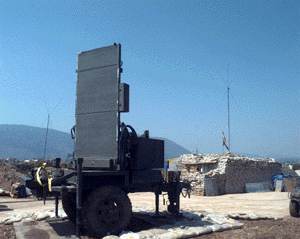The "Tactical Tomahawk" provides the US Navy with a great strike capability. Unfortunately, its ability to support tactical operations ashore is limited since targeting data must be received from external sources. This intelligence must be instantly transmitted to ships offshore free of enemy jamming and normal communications interference. These factors undermine the value of Tomahawks on fluid battlefields.
 The solution is to incorporate counterbattery computer software into the Aegis radar system. Navy tests in 1999 proved that the current Aegis system can track artillery
shells. Artillerymen have already perfected radar software that instantly locate the origin of small projectiles.
If this technology were
adapted to Aegis, Navy cruisers and destroyers could evaluate the speed, size, and trajectory of
ascending projectiles ashore and immediately target missile launchers, howitzers, mortars, and even anti-aircraft guns.
Since Aegis can guide Standard missiles to intercept supersonic aircraft, it can certainly guide
them (or 5-inch guns) to strike
targets ashore. If this proves difficult, the Navy can mount the
current AN/TPQ-36 Fire Finder Radar (below) on the deck of some ships.
The solution is to incorporate counterbattery computer software into the Aegis radar system. Navy tests in 1999 proved that the current Aegis system can track artillery
shells. Artillerymen have already perfected radar software that instantly locate the origin of small projectiles.
If this technology were
adapted to Aegis, Navy cruisers and destroyers could evaluate the speed, size, and trajectory of
ascending projectiles ashore and immediately target missile launchers, howitzers, mortars, and even anti-aircraft guns.
Since Aegis can guide Standard missiles to intercept supersonic aircraft, it can certainly guide
them (or 5-inch guns) to strike
targets ashore. If this proves difficult, the Navy can mount the
current AN/TPQ-36 Fire Finder Radar (below) on the deck of some ships.
 A sophisticated enemy may jam missiles guided by Aegis radar or GPS satellite signals. Therefore, the Navy should
develop a Radar Attack Standard Missile
(RASM) using the proven radar-seeking guidance of the AGM-88 HARM air-to-ground
missiles (below). When ships locate enemy radar emissions, RASMs can be
fired immediately.
As a RASM begins its descent in the vicinity of the radar site, the radar-seeker
takes control and guides the
missile to the source. RASMs can be employed against radar-guided anti-aircraft and anti-ship systems ashore, enemy
counterbattery radar, and
distant radar emitting ships. The US Army can benefit by deploying
RASMs that can be fired from its MLRS.
A sophisticated enemy may jam missiles guided by Aegis radar or GPS satellite signals. Therefore, the Navy should
develop a Radar Attack Standard Missile
(RASM) using the proven radar-seeking guidance of the AGM-88 HARM air-to-ground
missiles (below). When ships locate enemy radar emissions, RASMs can be
fired immediately.
As a RASM begins its descent in the vicinity of the radar site, the radar-seeker
takes control and guides the
missile to the source. RASMs can be employed against radar-guided anti-aircraft and anti-ship systems ashore, enemy
counterbattery radar, and
distant radar emitting ships. The US Army can benefit by deploying
RASMs that can be fired from its MLRS.
 Utilizing Aegis as a counterbattery
targeting system will greatly enhance the Navy's ability to strike targets ashore.
Enemy weaponry firing upon friendly ships, aircraft, or troops would face immediate destruction. This capability
would prove valuable in high intensity amphibious operations as well as small peacekeeping operations.
In fact, US Marines submitted an urgent request for this capability while
Marines were "peacekeeping" in Lebanon over 25 years ago. Even primitive guerrilla units firing simple mortars and anti-aircraft guns
would face detection and rapid destruction from ships offshore. Adapting Aegis to
detect small projectiles and guide Standard missiles, 5-inch guns, or Tomahawks does not require the development of new technology, only the incorporation of existing artillery
counterbattery software.
Utilizing Aegis as a counterbattery
targeting system will greatly enhance the Navy's ability to strike targets ashore.
Enemy weaponry firing upon friendly ships, aircraft, or troops would face immediate destruction. This capability
would prove valuable in high intensity amphibious operations as well as small peacekeeping operations.
In fact, US Marines submitted an urgent request for this capability while
Marines were "peacekeeping" in Lebanon over 25 years ago. Even primitive guerrilla units firing simple mortars and anti-aircraft guns
would face detection and rapid destruction from ships offshore. Adapting Aegis to
detect small projectiles and guide Standard missiles, 5-inch guns, or Tomahawks does not require the development of new technology, only the incorporation of existing artillery
counterbattery software.
©2015 www.G2mil.com